BestReviews is reader-supported and may earn an affiliate commission. Details
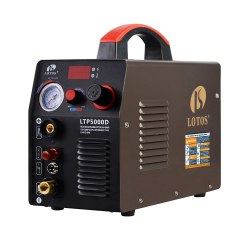
A great choice for a non-touch pilot arc tool.
Cuts through a majority of surfaces with relative ease. Does not produce as much waste. This solid unit has a convenient transport handle and uses compressed air as a medium.
Has a tendency to burn through the consumables quickly.
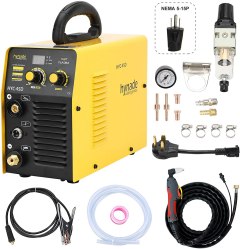
A great tool that comes with everything you need.
Has a dual voltage system. It comes with an inverter soft switch, hose clamp, and other needed supplies. Easy-to-read display. Can cut up to 12 mm.
The instructions are not the best for new users.
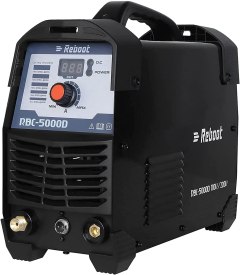
A solid unit that will cut almost anything you need.
Cuts up to 1/2 inch. Can cut through most metals. Has a 3-second blowback after the machine is turned off to get out any residue that may be in the tip.
The cord is a bit short so you will have to have the machine pretty close by.
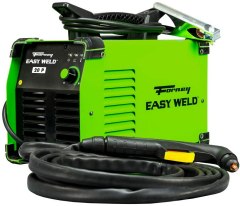
A great unit that will work for a majority of smaller jobs.
Can cut up to 1/4 inch of many mid-grade metals. Has a built-in regulator. Easy to set up and start. Comes with a great cutting torch and a solid ground clamp.
Can be pretty hard to get it to cut through a majority of sturdier metals.
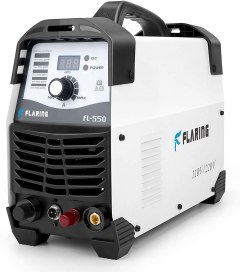
A great cutter that is easy to set up and transport.
Can cut up to 3/5 of an inch. It is a relatively quiet unit for the power it produces. Easy to change the voltage. Built in overheat protection. Comes with a 3 year limited warranty.
The LCD display can be a bit finicky.

We recommend these products based on an intensive research process that's designed to cut through the noise and find the top products in this space. Guided by experts, we spend hours looking into the factors that matter, to bring you these selections.

A plasma cutter might sound a bit like something out of Star Wars, but in fact, it’s a relatively easy-to-use and very versatile tool for all kinds of metal cutting. In basic terms, these machines use an electrical charge to create ionized gas (plasma) at very high temperatures. They can slice through steel, aluminum, and brass like a hot knife through butter!
Most plasma cutters are very portable, and the flexibility to make rapid rough cuts or work in fine detail makes them popular with a wide range of fabricators, contractors, auto engineers, hobby metalworkers, and even artists.

There are a number of important aspects to consider when looking for a plasma cutter: cutting capability, gas supply, duty cycle, and additional features.
Plasma cutters are usually rated by amperage. The higher the amps, the greater the potential thickness it can cut, or the faster the machine will cut for an equivalent thickness. However, two 50-amp machines can have different performance, so you need to look into the specifications in more detail to see what those actual thicknesses are.
There are four possible figures, though you’ll probably only get one or two for any particular machine:
Rated cut thickness: This is the maximum depth at a cutting speed of 10 inches per minute (IPM).
Recommended cut thickness: This is the machine working at its best combination of speed and efficiency. Because this is slower than a rated cut, it will be thicker. However, it’s defined by the manufacturer, so it’s a bit subjective.
Clean cut thickness: This is the maximum while maintaining a relatively smooth finish (also subjective).
Severance (or sever) cut thickness: This is the absolute maximum the machine is capable of, regardless of finish quality.
Entry-level plasma cutters might only manage to cut through 1/8-inch plate. High-end models are capable of exceeding 1 inch. Think about the thickness of the material you’ll be cutting most of the time and try to choose a plasma cutter that can cope with that comfortably. If you’re always pushing the tool to its limits, the cut quality will suffer, you’ll use more consumables, and you’ll likely shorten the machine’s life, so going for a cheaper, less powerful model is often false economy.
Argon, oxygen, and nitrogen can be used in plasma cutters, but ordinary air is cheap, efficient, and easy to supply via a compressor. Some models have them built in, but they’re expensive, and they can only do that one job. A separate portable compressor is a reasonably affordable alternative and gives you much more versatility. Many people already own one with sufficient power, but it’s important to check the consumption requirements of the plasma cutter you’re considering. You need to look at airflow, given as cubic feet per minute (CFM or SCFM) and pressure, given as pounds per square inch (psi).
Plasma cutters get very hot. Safety circuits should prevent them from overheating, but they need to rest from time to time. The active period is called the duty cycle, and it’s given as a percentage for a given amp rating. The higher the percentage, the longer it will cut continuously.
For example, if a particular model has a 60% duty cycle, then after 6 minutes of working it would need 4 minutes to cool down. That doesn’t mean it can only run for 6 minutes — that will depend on the power of the plasma cutter and the thickness of material being cut. Each machine should come with the relevant information.
Many plasma cutters offer dual voltage. Running off either 110 or 220 volts allows you to work off household or industrial supply.
Torch lead: The torch lead is important because of how it impacts your working comfort. If you do a lot of bench work, it won’t be a problem, but it can be surprisingly frustrating if you’re moving around a lot and it’s too short. A common length is 12 feet, though you can find up to 25 feet on heavy-duty machines.
Torch size: Torch size and shape can vary. There are compact models if you often have to get into tight spaces. If you’re using a plasma cutter for long periods, you’ll want to make sure it’s comfortable to hold.
On cheap plasma cutters, the nozzle has to be touched to the metal to start. If you want high accuracy, you need a very steady hand. Non-touch models allow you to guide the torch more easily onto the work. It’s a particularly useful feature if you’re working on uneven surfaces.
Drag technology allows you to run the nozzle across the surface once the cut has started. This lets you trace complex shapes with great precision. If you try the same with a non-drag machine, you can get a secondary arc that attempts to weld the nozzle to the material! It’s easy to break free, but it gives you a very stop-start jagged cut.
High-frequency (HF) starting (called a pilot arc) is common, but it can interfere with radio and TV signals and other sensitive equipment. Non-HF pilot arcs don’t cause the same problems.
Weight will be a consideration for those who need to move their plasma cutter from place to place. Almost all have carrying handles, but there’s a big difference between a 40-amp machine that weighs 20 pounds and a 65-amp model that weighs 70 pounds or more.
Your plasma cutter will probably come with a small selection of consumables — nozzles, electrodes, and so on. These will be an ongoing cost, so it’s worth comparing alternatives. You don’t have to buy from the same manufacturer, but it’s best to invest in quality. Cheap consumables can have a negative impact on the quality of your work.
Safety glasses: Hobart 770726 Shade 5 Mirrored Lens Safety Glasses
A stylish,modern design with tough, impact-resistant polycarbonate lenses, these glasses will protect your eyes from unpleasant flash radiation when plasma cutting without the need for bulky welding goggles or a full mask. They’re tested to the ANSI Z87.1 impact standard, scratch resistant, and cheap, too!
Air compressor: Makita Portable Air Compressor
The air supply demands of plasma cutters vary, but all the top-rated models we looked at require 3.5 SCFM, or better, and a minimum of 60 psi. The 2.5-horsepower Makita comfortably exceeds those figures, is very portable, and has a terrific reputation for reliability and durability.
Inexpensive: Although you can find cheap plasma cutters for around $150, performance and reliability can be questionable. We’d look at spending $250 or so for a good machine.
Mid-range: Between $300 and $500 you’ll find a wide choice of tools that will satisfy most users. Unless you’re a full-time professional or you want a built-in compressor, there’s little reason to pay more. You’ll also find several good plasma cutter/welder combo machines in this price range.
Expensive: If you want a compressor in the same unit, you’ll pay upwards of $600. If you need maximum cutting capacities — severance capabilities of an inch or more — prices can top $3,000.


Q. Can I use a welding torch as a plasma cutter?
A. Not really. Yes, you can cut through some metals, but a torch doesn’t have anything like the power of a plasma cutter. It’s slower, and you have virtually no control. The finish also tends to be poor. If you want an accurate, professional job, you need to invest in the proper tool.
Q. What is arc eye?
A. Arc eye, or welder’s flash, is an inflammation of the corneas that you get from exposing your eyes to ultraviolet light during plasma cutting or welding. It might not be noticed right away, but a few hours later your eyes will be extremely itchy and painful and water a lot. Avoiding it is easy: always wear welder’s safety glasses, goggles, or mask.
Q. Are the fumes from plasma cutting harmful?
A. They can be. For example, cutting stainless steel and other metals that incorporate chromium releases hexavalent chromium, which attacks the skin and is associated with lung cancer when inhaled. Other metals can produce respiratory or nerve damage. The Occupational Safety and Health Administration (OHSA) produces guidelines for different materials and safe exposure times. Personal safety in this case is mostly about having adequate ventilation in your workshop.
Get emails you’ll love.
Learn about the products you’re wondering if you should buy and get advice on using your latest purchases.
